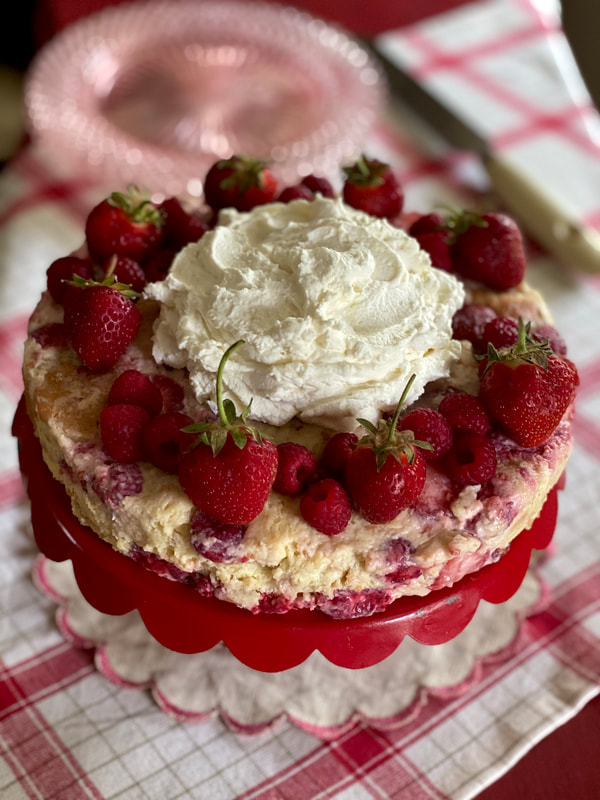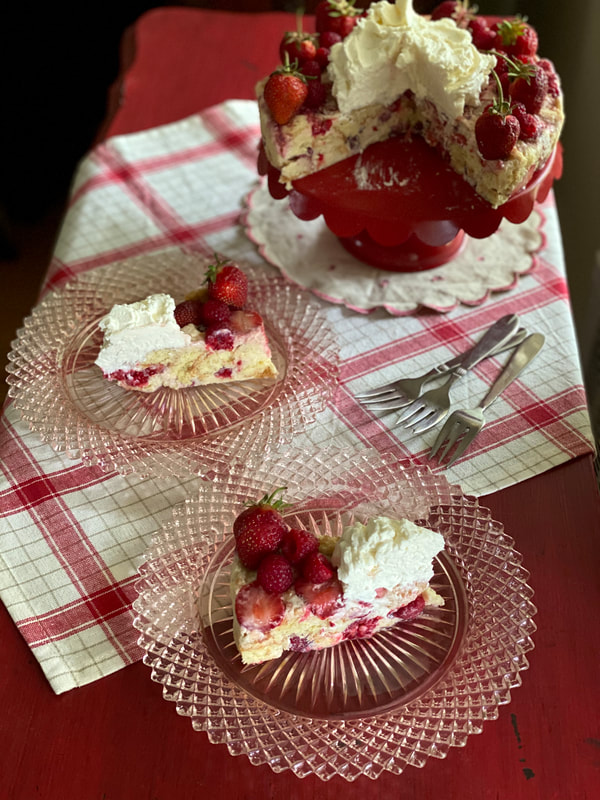|
one 9” blind-baked pie shell
For the filling- 3 pounds (about 7 large) ripe peaches, rinsed, peeled, pitted, cut into thick wedges 1 tablespoon lemon juice 1 teaspoon lemon zest ½ cup granulated sugar ¼ cup dark brown sugar pinch of salt ⅛ teaspoon freshly grated nutmeg 2½ tablespoons cornstarch ¼ teaspoon almond extract (optional) 1 tablespoon unsalted butter, cut into ½” pieces Place the peaches in a large bowl and toss with the lemon juice, lemon zest, sugars, salt and nutmeg. Let the peaches macerate for 15 minutes. Transfer the peach slices to a colander and set the colander over the same bowl used to combine the peaches with the sugars and spices. Let the peaches sit for at least 30 minutes, and up to two hours. Transfer the juices (you should have almost 1 cup of liquid) to a heavy bottomed saucepan. Reduce the juices over low heat, swirling the liquid, until it has reduced down to about ½ cup. Remove from the heat and set the syrup aside to cool slightly. Pre-heat the oven to 350 degrees F and prepare the biscuit topping. For the biscuit topping- 1¼ cups all-purpose flour 1 cup yellow cornmeal (for more texture, use ½ cup of fine and ½ cup coarse) ⅓ cup packed dark brown sugar 1 teaspoon orange zest 1½ teaspoons baking powder ¼ teaspoon salt 5 oz. cold unsalted butter, cut into ½” pieces ¾-1 cup cold buttermilk egg wash made from 1 egg beaten with 1 tablespoon milk or cream coarse sanding sugar for sprinkling In a large bowl, whisk together the cornmeal, brown sugar, orange zest, baking powder, and salt. Cut the cold butter pieces into the dry ingredients using a butter cutter or your fingertips. The mixture should be pebbly with some larger pieces of butter. Gradually add ¾ cup of the buttermilk, tossing the mixture gently with a fork until it is well combined. (If the mixture feels dry, you can add up to ¼ cup more of the buttermilk. The mixture should be fluffy, not soggy.) Turn the biscuit dough out onto a lightly floured work surface and pat the dough into a circle, about 1” thick. Use biscuit cutters (mine measure 2¼” across the top) to cut out circles of dough, gently rerolling the scraps once. Transfer the biscuits to a parchment lined baking sheet, cover with plastic wrap and refrigerate while you finish the filling. To complete the pie filling, transfer the peach slices to a bowl and toss with the cornstarch, making sure the cornstarch dissolves. Add the almond extract and pour the reduced, cooled, peach syrup over the peaches, turning to coat with a spatula. Transfer the peaches and their juices to the blind baked/cooled pie shell. Dot the peaches with butter. Retrieve the biscuits from the refrigerator, brush them with the egg wash and sprinkle with the sanding sugar. Cover the peaches with the biscuits, trimming as needed to fit. Leave a small opening in the center of the pie, allowing steam to escape. Place the pie on a parchment lined baking sheet and bake on the middle rack of the oven for 30 minutes. Reduce the oven temperature to 325 degrees F and bake for an additional 50-60 minutes, until juices bubble around the edges and through the middle of the pie. Transfer to a rack and let the pie cool for at least 4 hours before slicing. Cover any leftovers in plastic wrap. Pie can sit at room temperature for up to 3 days.
0 Comments
Vanilla extract is a pantry staple that we take for granted. Before vanilla extract in the small bottle with the red cap became widely available, dry sherry was a common go-to flavoring for bakers. If you don’t have any sherry in the cupboard, Lillet or a dry vermouth makes a fine substitute.
Any simple spongecake or angel food cake will work in this recipe- you will need approximately 4 cups of cake cubes. Gently cut the sponge cake (or if you prefer, angel food) into 1” cubes using a serrated knife. (There should be a little extra cake for nibbling.) I use an 8” springform cake for the spongecake. After the cake is baked, I turn it out, wash the pan and use it to assemble the finished dessert. makes one 8” round cake Preheat the oven to 375 degrees F. Line the cake pan with a circle of parchment paper, lightly butter the parchment (not the sides of the pan.) Set the springform pan on a baking sheet. For the spongecake- 4 large eggs, separated pinch salt ¼ cup sugar, divided (2 tablespoons for the whites, 2 tablespoons for the yolks) 1 teaspoon vanilla ¼ cup sifted all-purpose flour ¼ cup sifted cornstarch In the bowl of a standing mixer fitted with the whisk attachment or in a large bowl using a handheld electric mixer, beat the egg whites with the salt until foamy. Gradually add 2 tablespoons of sugar, beating until the whites hold their shape but are not dry. In a large bowl, whisk the egg yolks and vanilla, then gradually add the remaining 2 tablespoons of sugar, whisking constantly until the sugar dissolves and the yolks are thick and ribbon-y. Fold about one fourth of the beaten whites into the yolk mixture. Pour the egg yolk mixture into the beaten whites; sprinkle the sifted flour and cornstarch through a fine mesh strainer over the egg white mixture, folding together gently but thoroughly, without over mixing. Spread the batter in the springform pan, using a small offset spatula to even the batter, spreading it to the corners. Bake the cake just until the edges are set and the cake is golden, 20-25 minutes. Cool the cake in the pan for 10 minutes. Carefully remove the sides of the pan (gently run an offset spatula around the sides then unhinge the pan) and let the cake cool completely. Carefully peel the parchment paper off the bottom of the cake. Cut the cake into 1” cubes. Wash the sides and the bottom of the pan. Reassemble the pan. For the custard- (from Elizabeth Terry) 1 1/2 teaspoons unflavored gelatin 1/4 cup warm water, plus 2 tablespoons tap water 2 egg yolks 1/4 cup good dry sherry (I’ve substituted Lillet) 1/4 cup plus 2 tablespoons sugar 1 cup heavy cream 2 teaspoons vanilla extract In a small bowl or ramekin, sprinkle the gelatin over the warm water, and set aside to ‘bloom.' In a mixing bowl, beat the egg yolks until pale, then stir in the sherry, 1/4 cup of the sugar, and the 2 tablespoons of water, then transfer to a medium saucepan. Stir constantly over medium heat until the custard thickens, and begins to bubble around the surface, about 5 minutes. Remove the pan from the heat. Whisk in the gelatin mixture, and continue to whisk until the gelatin is completely dissolved. Place the pan over an ice bath (a bowl filled with ice and cold water) and stir until the mixture is cool, being careful that the gelatin does not set. (If it does, you can briefly warm it over warm water; rub the mixture between your fingers to make sure it is smooth.) In a chilled bowl, whip the cream with the remaining 2 tablespoons sugar and the vanilla. Gently fold the cream into the cooled custard and then fold in the spongecake cubes. To assemble- 2 cups fresh berries (preferably raspberries and local strawberries) To garnish- 1 cup heavy cream whipped with 1 tablespoon powdered sugar additional berries Sort through the berries to remove any stems. Rinse them VERY LIGHTLY (more of a mist than a rinse) and dry them on paper towels. Spread one half of the custard/cake over the bottom of the springform pan. Sprinkle one cup of berries over the custard/cake. Top with the remaining custard/cake and the remaining berries, saving a few for garnish. Cover the cake with plastic wrap and refrigerate for at least two hours before serving. Carefully remove the side of the springform pan. Place the cake on a serving plate. Serve the whipped cream alongside the cake with additional berries. Cover and refrigerate any leftovers. |
Archives
July 2024
|


 RSS Feed
RSS Feed